Is there a built-in way to quantify results of agrep function? E.g. in
agrep("test", c("tesr", "teqr", "toar"), max = 2, v=T)
[1] "tesr" "teqr"
tesr is only 1 char permutation away from test, while teqr is 2, and toar is 3 and hence not found. Apparently, tesr has higher "probability" than teqr. How can it be retrieved either in number of permutations or percentage?
Thanks!
Edit: Apologies for not putting this in question in first place. I am already running a two-step procedure: agrep to get my list, and then adist to get N permutations. adist is slower, running time is a big factor in my dataset
